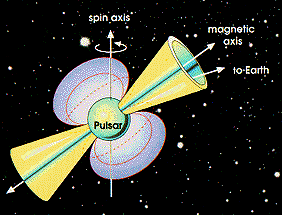Information about neutron stars
Pulsars and neutron stars
Sometimes these objects emit X-rays in a very rapid regular, periodic pattern. These objects are called X-ray pulsars. Pulsars, it is believed, are spinning neutron stars. A neutron star is the superdense remains of an exploded star that gravitationally collapsed back in on itself to form a small, compressed core of neutrons. When a neutron star is in a binary system with a sun-like star, matter is gravitationally pulled off this stellar companion. We can think of it this way: "It's the sound of matter going splat," says UC Berkeley astrophysicist Jonathan Arons. During this process, X-rays are emitted.
More specifically, pulsars have jets of particles moving at the speed of light streaming out of their two magnetic poles. These jets produce very powerful beams of light. We know that on Earth, the spin axis (true north) is not the same as the magnetic axis. This is also seen in X-ray pulsars. Therefore, the beam of light from the jet sweeps around as the pulsar rotates, like the spotlight in a lighthouse does. As a ship in the ocean that sees only regular flashes of light, we on Earth see pulsars turn on and off as the beam sweeps over the Earth.

You see, how much mass the star had when it died determines what it becomes. Stars about the same size as the Sun become white dwarfs, which glow from left over heat. Stars that have about 3 times or more the mass of the Sun compact into neutron stars. And a star with mass many, many times the Sun's gets crushed into a single point, which we call a black hole.
The characteristics of such stars listed on the previous two pages are also going to be features of the types of stars which the students will be examining today with Folding.
A neutron star is the super dense remains of an exploded star that gravitationally collapsed back in on itself to form a small, compressed core of neutrons. It is not unusual for a neutron star to emit X-rays. When a neutron star is in a binary system with a sun-like star, matter is gravitationally pulled off this stellar companion. As the matter falls toward the neutron star, it emits X-rays. We can think of it this way: "It's the sound of matter going splat," says UC Berkeley astrophysicist Jonathan Arons.
Sometimes the emitted X-rays are pulsed, or modulated, by the spinning of the neutron star.

